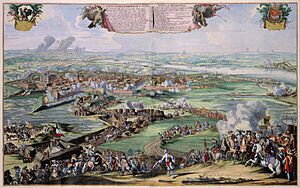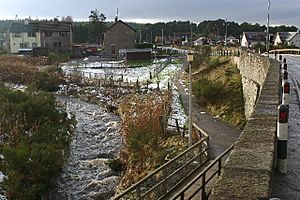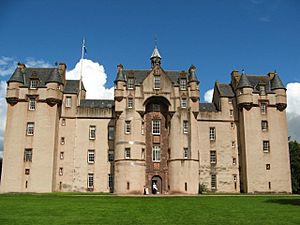Thomas Buchan facts for kids
Quick facts for kids
Thomas Buchan
|
|
|---|---|
| Born | ca 1641 Logie-Buchan, Aberdeenshire Scotland |
| Died | 1724 (aged 82–83) Fyvie |
| Buried |
Logie-Buchan
|
| Allegiance | |
| Years of service | 1668–1692 |
| Rank | Major General |
| Unit | Dumbarton's Regiment 1668–1678 Dutch Scots Brigade 1678–1682 Earl of Mar's Regiment 1682–1688 |
| Commands held | Jacobite military commander in Scotland 1690–1692 |
| Battles/wars | Franco-Dutch War 1672–78 Argyll's Rising 1685 Williamite War in Ireland 1689–1690 Jacobite Rising Scotland 1690–92 |
Thomas Buchan (around 1641–1724) was a Scottish soldier. He came from a Catholic family in Aberdeenshire. Thomas served in the armies of France, the Netherlands, and Scotland.
He stayed loyal to King James II after the Glorious Revolution in 1688. This event changed who was king in Britain. Thomas fought in the War in Ireland before leading Jacobite forces in Scotland in 1690. The Jacobites were people who supported King James.
After Highland chiefs gave up to King William III in 1692, Thomas was allowed to go to France. He returned home in 1703. He kept in touch with the Stuart family, who were in exile. He also played a small part in the Jacobite rising of 1715. This was another attempt to bring the Stuarts back to power. Thomas was not punished and died in Fyvie in 1724.
Contents
Early Life and Family
Thomas Buchan was the third son of James Buchan of Auchmacoy. His mother was Margaret Seton. Both his parents were part of the small Catholic group in Scotland. During this time, family ties and politics were very complicated.
For example, his younger brother, John Buchan, became a Colonel in the army of King William III. To do this, John had to be a Protestant. On the other hand, one of Thomas's nephews, James Buchan, served in the Jacobite and French armies. His oldest nephew, Alexander, became a Jesuit priest.
In 1703, Thomas was allowed to come back to Scotland. This was part of a general pardon for people who had supported King James. In 1704, he married Elizabeth Urquhart. She was the widow of Sir George Gordon. Elizabeth was also the sister of one of Thomas's friends. Thomas and Elizabeth did not have any children. Elizabeth passed away in 1710.
Military Career
Many Scots who wanted to be soldiers had to work for other countries. This was because Scotland did not have a large standing army. In 1668, Thomas Buchan joined the 'Régiment de Douglas.' This was a Scottish mercenary unit, meaning they fought for money.
This regiment was led by George Douglas, 1st Earl of Dumbarton, another Scottish Catholic. They mostly served with the French army from 1633 to 1678. This included fighting in the Franco-Dutch War from 1672 to 1678. When that war ended in 1678, Thomas and his brother John joined the Dutch Scots Brigade. This was another long-standing mercenary group.
Many officers in the Scots Brigade were Scottish or English exiles. Thomas later said that King James asked him to join this group. King James wanted to keep an eye on these exiles.
Return to Scotland and the Glorious Revolution
Thomas Buchan came back to Scotland in 1682. He joined the Royal Scots Fusiliers. He helped defeat Argyll's Rising in June 1685. This was a rebellion against King James. Thomas was promoted to Colonel in July 1686. His brother John stayed with the Scots Brigade. John fought for the government at the battle of Killiecrankie in 1689. He was also promoted to Colonel and served King William in Flanders until 1697.
In November 1688, William of Orange landed in England. This event is known as the Glorious Revolution. Most of the Scottish army joined King James in England. Thomas Buchan was a Brigadier at this time. Most soldiers switched their loyalty to William. However, Thomas stayed loyal to King James, like most Catholic officers. He went with James into exile and then to Ireland in 1689.
Leading Jacobite Forces in Scotland
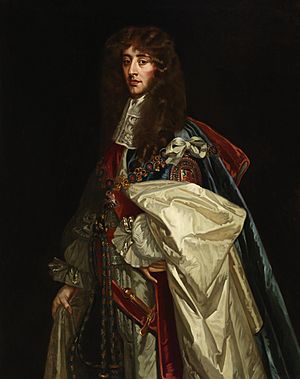
Thomas was chosen to go to Scotland in July 1689. His job was to help Dundee, who was leading the Jacobite forces there. But Thomas was needed for the siege of Derry in Ireland. So, Alexander Cannon, another officer, went instead. Cannon took over after Dundee died in July 1689 at the battle of Killiecrankie. In February 1690, Thomas Buchan finally arrived in Scotland to take command.
The main challenge for Jacobite leaders like Thomas was getting outside help. They needed a port to receive supplies and weapons. This also meant they needed siege equipment. Highland forces mostly fought in open battles, not sieges. Without proper equipment, they could only fight a small-scale guerrilla war. This type of fighting put a lot of pressure on the local people.
King William's general, Hugh Mackay, kept fighting through the winter of 1689-1690. He captured strongholds like Blair Castle and built new forts like Fort William. The harsh winter also caused severe food shortages.
The Battle of Cromdale
These problems stopped the Jacobites from gathering a large army for the 1690 campaign. In March, Thomas Buchan and Lochiel wrote to King James. They asked for money, weapons, and 4,000 foot soldiers. They also asked for 1,000 cavalry led by James's son, the Duke of Berwick. Getting this much help was not realistic. Asking for someone as important as Berwick showed that senior Scottish leaders were not giving much support.
Thomas Buchan gathered about 1,200 men. But this number quickly dropped to less than 700. On May 1, 1690, his forces were surprised and scattered at the Battle of Cromdale.
Later Years and Return Home
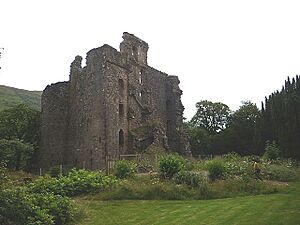
Thomas and others escaped after Cromdale. They went to Aberdeenshire, an area with many Catholic Gordons. This area had been a Royalist stronghold since the 1630s. There were many supporters there, including clansmen loyal to Colonel John Farquharson. Thomas managed to gather a few hundred men. But he could not attack Aberdeen itself. His forces soon dwindled away again.
The Jacobite resistance mostly ended when Kenneth Mackenzie, 4th Earl of Seaforth surrendered. Thomas Buchan found safety in Lochaber. He was protected by the MacDonald chief Glengarry. After the Highland chiefs gave up in December 1691, Thomas and others, including Alexander Cannon, were allowed to go to France in March 1692.
Thomas Buchan was blamed for the failure of the 1690 campaign. He never led an army again. In 1703, he was allowed to return home under a general pardon. He stayed in touch with the exiled Stuart family. In 1707, he checked the defenses of Inverness for a Jacobite agent.
A Jacobite politician named George Lockhart mentioned Thomas in his journals for 1708. Thomas was one of several Scottish Catholics asked to help prepare for a failed invasion in 1708. He offered his help during the 1715 Jacobite rising. He was briefly forced to leave Scotland again. But he returned home in 1717. Thomas Buchan died at his wife's home in Fyvie in 1724.


